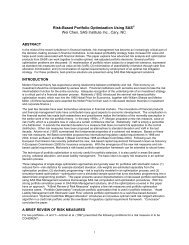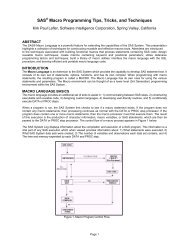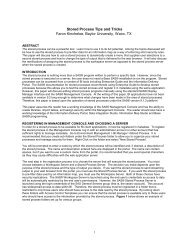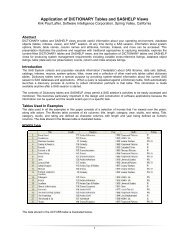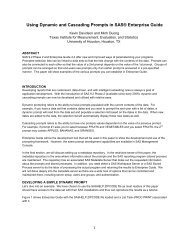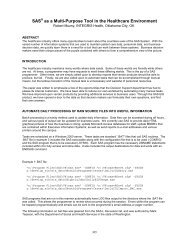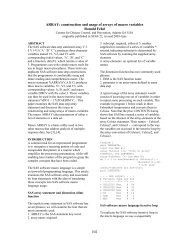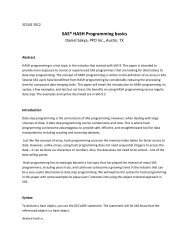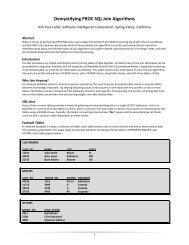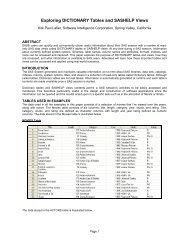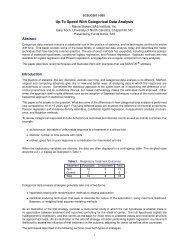Coding ICD-9 and Charlson Index Scores in R for SAS Users ...
Coding ICD-9 and Charlson Index Scores in R for SAS Users ...
Coding ICD-9 and Charlson Index Scores in R for SAS Users ...
Create successful ePaper yourself
Turn your PDF publications into a flip-book with our unique Google optimized e-Paper software.
health by assess<strong>in</strong>g a set of comorbidities, some with higher ranks than others. This <strong>in</strong>dex has<br />
been validated <strong>in</strong> numerous studies as to the accuracy of patient health denoted by the <strong>Charlson</strong><br />
<strong>Index</strong> rat<strong>in</strong>g. The <strong>ICD</strong>-9 code is a way to st<strong>and</strong>ardize how comorbidities are recorded. With so<br />
much electronic <strong>in</strong><strong>for</strong>mation available, a st<strong>and</strong>ardized system <strong>for</strong> collect<strong>in</strong>g disease <strong>in</strong><strong>for</strong>mation<br />
becomes extremely helpful when analyz<strong>in</strong>g data.<br />
The <strong>Charlson</strong> R package created <strong>in</strong> this project accomplishes two th<strong>in</strong>gs. First, it recodes<br />
Statistical Classification of Diseases <strong>and</strong> Related Health Problems version 9 (<strong>ICD</strong>-9) entries <strong>in</strong>to<br />
categories useful <strong>for</strong> comput<strong>in</strong>g the <strong>Charlson</strong> <strong>Index</strong>. Second, it computes the <strong>Charlson</strong> <strong>Index</strong> <strong>for</strong><br />
entries <strong>in</strong> a dataset. It conta<strong>in</strong>s one function named <strong>Charlson</strong>, which takes two vector arguments.<br />
Methods<br />
A function named <strong>Charlson</strong> was developed <strong>in</strong> R (Complete code is <strong>in</strong> Appendix 1). After<br />
writ<strong>in</strong>g the function, an R package was built. The package <strong>in</strong>cludes the code, a description of the<br />
code, <strong>in</strong>put variables, output from the function, sample data set, <strong>and</strong> examples. This package<br />
requires the Reshape <strong>and</strong> Plyr packages to run properly. The melt <strong>and</strong> cast functions from<br />
Reshape are used <strong>in</strong> <strong>Charlson</strong>, while the Reshape package itself requires Plyr. To create an R<br />
package, the basic steps per<strong>for</strong>med were:<br />
1. Open a clean R session.<br />
2. Load the data sets.<br />
3. Run the functions.<br />
4. Run the function package.skeleton. This created the basic structure of the files <strong>and</strong><br />
directories needed <strong>for</strong> a package.



